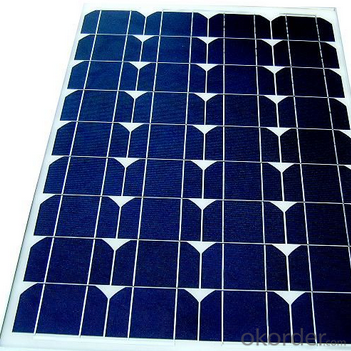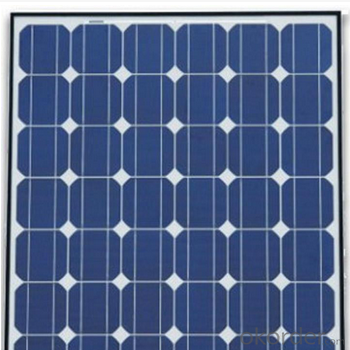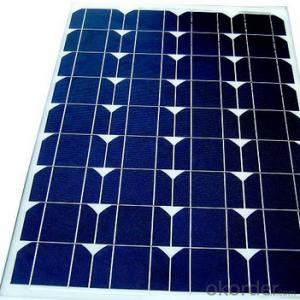High efficiency 250W mono solar module ICEM-7
- Loading Port:
- China main port
- Payment Terms:
- TT OR LC
- Min Order Qty:
- 200 watt
- Supply Capability:
- 50000 watt/month
OKorder Service Pledge
OKorder Financial Service
You Might Also Like
Instruction
1. Low voltage-temperature coefficient allows higher power output at high-temperature condition.
2. High efficient, high reliable solar cells ensure our product output stability.
Feature
1. Manufactured in an ISO9001:2008 certified plant
2. High efficiency, high safety, high reliability
3. Output power tolerance of +/-3%
Images


Specification
Electrical Characteristic of Mono Solar Cells
Efficiency (%) | Pmpp (W) | Umpp (V) | Impp (A) | Uoc (V) | Isc (A) | FF (%) |
18.35 | 4.384 | 0.526 | 8.333 | 0.63 | 8.877 | 78.39% |
18.20 | 4.349 | 0.526 | 8.263 | 0.63 | 8.789 | 78.54% |
18.05 | 4.313 | 0.525 | 8.216 | 0.63 | 8.741 | 78.32% |
17.90 | 4.277 | 0.524 | 8.161 | 0.629 | 8.713 | 78.04% |
17.75 | 4.241 | 0.523 | 8.116 | 0.629 | 8.678 | 77.70% |
17.60 | 4.206 | 0.521 | 8.073 | 0.628 | 8.657 | 77.36% |
17.45 | 4.170 | 0.519 | 8.039 | 0.628 | 8.633 | 76.92% |
17.30 | 4.134 | 0.517 | 8.004 | 0.626 | 8.622 | 76.59% |
17.15 | 4.098 | 0.516 | 7.938 | 0.625 | 8.537 | 76.80% |
17.00 | 4.062 | 0.512 | 7.933 | 0.625 | 8.531 | 76.18% |
16.75 | 4.002 | 0.511 | 7.828 | 0.625 | 8.499 | 75.34% |
16.50 | 3.943 | 0.510 | 7.731 | 0.625 | 8.484 | 74.36% |
FAQ
We have organized several common questions for our clients,may help you sincerely:
1. What’s price per watt?
A: It’s depends on the quantity, delivery date and payment terms of the order. We can talk further about the detail price issue. Our products is high quality with lower price level.
2. Can you tell me the parameter of your solar cells?
We have different series of cells with different power output, both from c-si to a-si. Please take our specification sheet for your reference.
3. How do you pack your products?
We have rich experience on how to pack the panels to make sure the safety on shipment when it arrives at the destination.
- Q:What are the advantages of monocrystalline silicon and polycrystalline silicon in solar power?
- no mechanical groove in the same area on the efficiency of 16%, using buried gate structure, mechanical groove in the 130 square centimeters of polycrystalline Battery efficiency of 15.8%. (1) monocrystalline silicon solar cells
- Q:Are solar cells weather-resistant?
- Yes, solar cells are weather-resistant. They are designed to withstand various weather conditions such as rain, snow, heat, and cold. However, extreme weather events like hurricanes or hailstorms can potentially damage solar cells.
- Q:What is the difference between a solar cell and a solar panel?
- A solar cell is the basic unit that converts sunlight into electricity, while a solar panel is a collection of multiple solar cells arranged in a larger structure to generate a higher amount of electricity.
- Q:What are the disadvantages of using solar cells?
- One disadvantage of using solar cells is their high initial cost. The installation and purchasing of solar panels can be expensive for homeowners or businesses, making it less accessible for some people. Additionally, solar energy production is dependent on weather conditions, meaning that cloudy or rainy days can lead to reduced efficiency. Finally, the production of solar cells requires rare materials, such as silicon, which can have negative environmental impacts if not managed properly.
- Q:Can solar cells be used to power water treatment plants?
- Yes, solar cells can be used to power water treatment plants. Solar energy can be converted into electricity using photovoltaic technology, which can then be utilized to power the various systems and processes involved in water treatment, such as pumps, filters, and disinfection systems. Solar power offers a sustainable and environmentally friendly solution for powering water treatment plants, particularly in areas with abundant sunlight.
- Q:How do solar cells perform in areas with high levels of bird droppings?
- Solar cells can experience a decrease in performance in areas with high levels of bird droppings. The droppings can block sunlight, reducing the amount of light reaching the solar cells and thereby diminishing their efficiency. Regular cleaning and maintenance can mitigate the impact of bird droppings on solar cell performance.
- Q:Can solar cells be used in public transportation?
- Yes, solar cells can be used in public transportation. They can be integrated into vehicles such as buses, trams, or trains to harness solar energy and power various onboard systems. Solar panels on the roof can generate electricity to charge batteries, power lighting and ventilation systems, or even propel the vehicle itself. This helps reduce reliance on traditional fuel sources and decreases carbon emissions, making public transportation more sustainable and environmentally friendly.
- Q:Can solar cells be used in space stations?
- Yes, solar cells can be used in space stations. In fact, they are commonly used to provide power to space stations by converting sunlight into electricity.
- Q:What is the payback period for solar cells?
- The payback period for solar cells refers to the amount of time it takes for the cost of installing and maintaining solar cells to be recouped through the savings generated from reduced or eliminated electricity bills. Typically, the payback period for solar cells ranges from 5 to 10 years, depending on factors such as installation cost, energy consumption, government incentives, and regional sunlight availability.
- Q:How much do solar cells cost?
- The cost of solar cells can vary depending on various factors such as the type and size of the system, installation requirements, location, and quality of the panels. On average, residential solar panel systems can range from $10,000 to $30,000 or more. However, it is important to consider long-term savings on electricity bills and potential government incentives that can offset the initial investment.
1. Manufacturer Overview |
|
|---|---|
| Location | |
| Year Established | |
| Annual Output Value | |
| Main Markets | |
| Company Certifications | |
2. Manufacturer Certificates |
|
|---|---|
| a) Certification Name | |
| Range | |
| Reference | |
| Validity Period | |
3. Manufacturer Capability |
|
|---|---|
| a)Trade Capacity | |
| Nearest Port | |
| Export Percentage | |
| No.of Employees in Trade Department | |
| Language Spoken: | |
| b)Factory Information | |
| Factory Size: | |
| No. of Production Lines | |
| Contract Manufacturing | |
| Product Price Range | |
Send your message to us
High efficiency 250W mono solar module ICEM-7
- Loading Port:
- China main port
- Payment Terms:
- TT OR LC
- Min Order Qty:
- 200 watt
- Supply Capability:
- 50000 watt/month
OKorder Service Pledge
OKorder Financial Service
Similar products
New products
Hot products
Related keywords



























